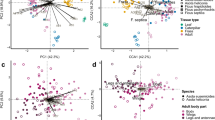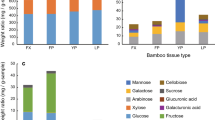Summary.
Myrmecophytic plants use obligate ant mutualists as a constitutive indirect defence mechanism. These plants often produce cellular food bodies (FBs) to nourish their resident ants. Lipids, proteins, and even highly specialised compounds such as glycogen have been reported from FBs, but detailed chemical analyses of FB composition have so far been presented only for Southeast Asian Macaranga and Central American Piper myrmecophytes. Here we report the chemical composition of FBs of five myrmecophytic Acacia (Fabaceae) species from Mexico using HPLC (carbohydrates and proteins) and GC-MS (lipids). Feeding experiments revealed no hints on any use of external food sources by the inhabiting Pseudomyrmex ants. These ants obviously rely completely on FBs and extrafloral nectar provided by their hosts. The total content of nutrients in Acacia FBs was 15-25% of FB dry mass, being much lower than in Macaranga or Piper FBs. Proteins were dominating (8-14 % dm) in Acacia FBs and thus were present in higher amounts than in Macaranga FBs, yet in lower amounts than in Piper. Lipids contributed 1-9 % of dry mass, showing a lower proportion than in FBs of Macaranga or Piper. Carbohydrates made up 3-11 % dm, reaching in most Acacia species the same range as observed in Macaranga and in Piper FBs. Water content was 18-24 % of FB fresh mass, and structural tissue obviously made up a much higher proportion in Acacia FBs than in Macaranga or Piper FBs. Both characters might represent an adaptation to producing FBs unprotected at the leaf tips under dry conditions. Acacia FBs contain all amino acids and all fatty acids that are considered essential for insects, and their contents of lipids and proteins are higher than in the leaves from which they are ontogenetically derived. This indicates a putatively adaptive enrichment of nutritionally valuable compounds in structures functioning as ant-food.
Similar content being viewed by others
Author information
Authors and Affiliations
Corresponding author
Rights and permissions
About this article
Cite this article
Heil, M., Baumann, B., Krüger, R. et al. Main nutrient compounds in food bodies of Mexican Acacia ant-plants. Chemoecology 14, 45–52 (2004). https://doi.org/10.1007/s00049-003-0257-x
Received:
Accepted:
Issue Date:
DOI: https://doi.org/10.1007/s00049-003-0257-x




